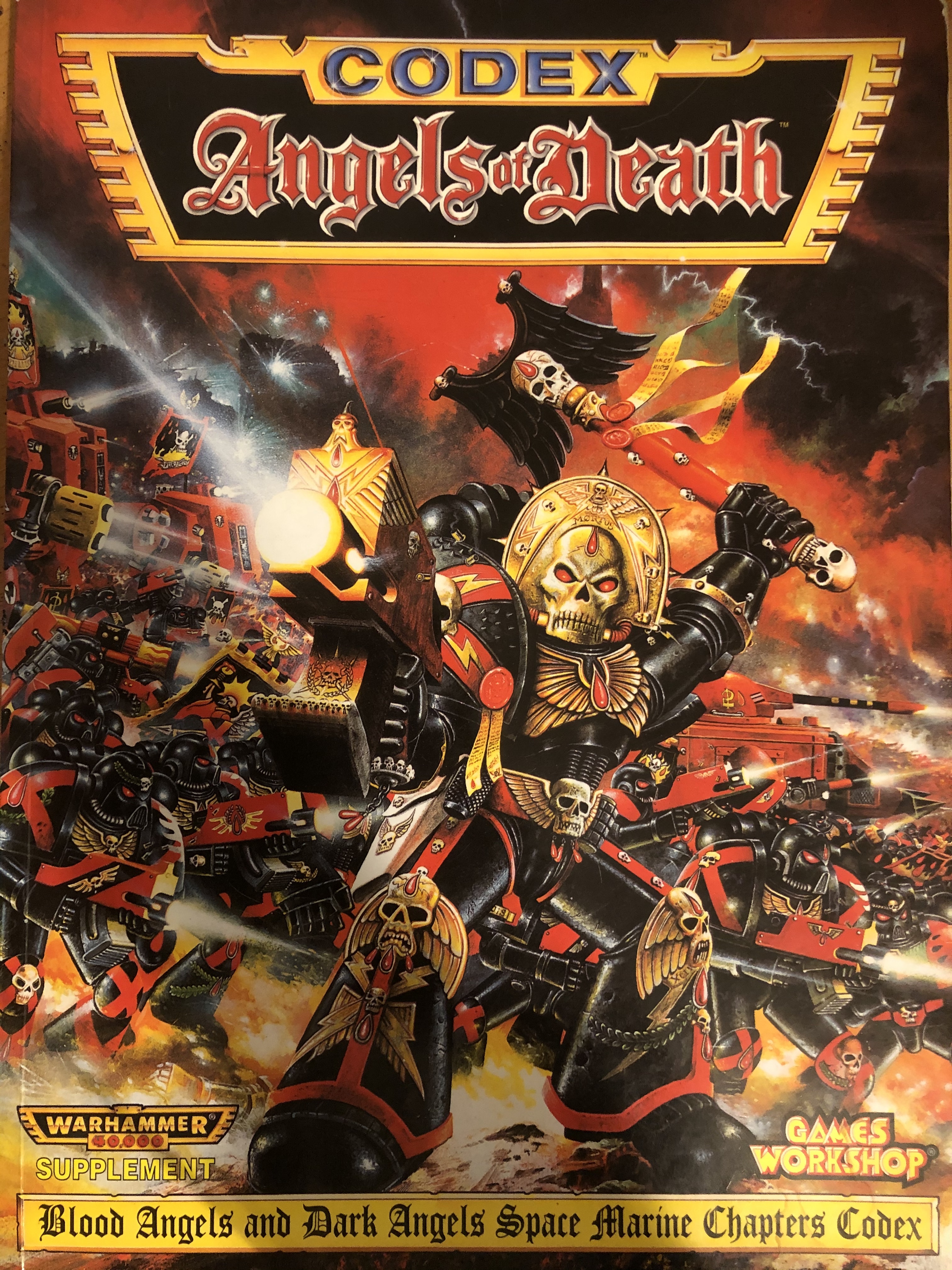Hey, wake up. You must have been having a weird dream, you were mumbling something about a boat that got stuck? We were playing Sega Saturn while you were out, but it’s time to read about the latest Warhammer 40,000 codex, Angels of Death.
We’re here with the rare – singular, in fact: this is the only one they ever made – Double Codex, covering both flavors of Angel, both Blood and Dark. This was the third Space Marines codex of second edition 40k, following Ultramarines and, inexplicably, Space Wolves.
This isn’t going to follow the format of our normal non-shenanigans codex reviews, because those are a ton of work that isn’t worth it for a book older than some of our readers, for a version of the game that nobody plays. It’s not going to be fully-shenanigans either, because trying to keep that going as a Bit – haha whoa check it out, there’s no Primaris marines, and the las-plas Razorback is back, this is crazy – would wear out its welcome immediately, and I refuse to do it.
I should say here that I never played second edition. I showed up to the party early in 4th, my earliest book being an out-dated copy of the 3rd edition core rules that Rob “TheChirurgeon” Jones threw at me when he didn’t need it anymore. This is notable mostly for making myself feel indescribably decrepit, but also to show you how far back his history of owning me goes. I only picked the book up a few years ago, when someone was selling a trove of 2nd edition stuff. I scored this, the Tyranids and Imperial Guard codexes, and the Chaos one, but I gave that to Rob, as a form of revenge for that rulebook oh so many years ago.
At any rate, nostalgia has no grip on me: this is not the 40k I grew up with, and I have no particular attachment to it that would allow me to view the insanity as mere quirkiness. This is all very new, and I don’t have any context for why this book is the way that it is. Why does the land raider entry have a stat block for the crew, but not armor facings for the tank itself? On that note, just to level-set on exactly how much I don’t understand, since when are crew even a thing? Can they get out? Are there Activities for them to perform? What does a storm shield even do (I checked with Rob and Dylan on this, and it’s in a different book, which feels like something that Angels of Death should at least mention, but reader, it does not).
Honestly? This owns. Because if you don’t know what you’re looking at, without the datafaxes, a Biker Squad has basically the same stats as a Servitor. Which is, according to the army list, what a Tarantula apparently is: a 20 point model, which doesn’t have stats, but does have a technician operating a multi-melta.
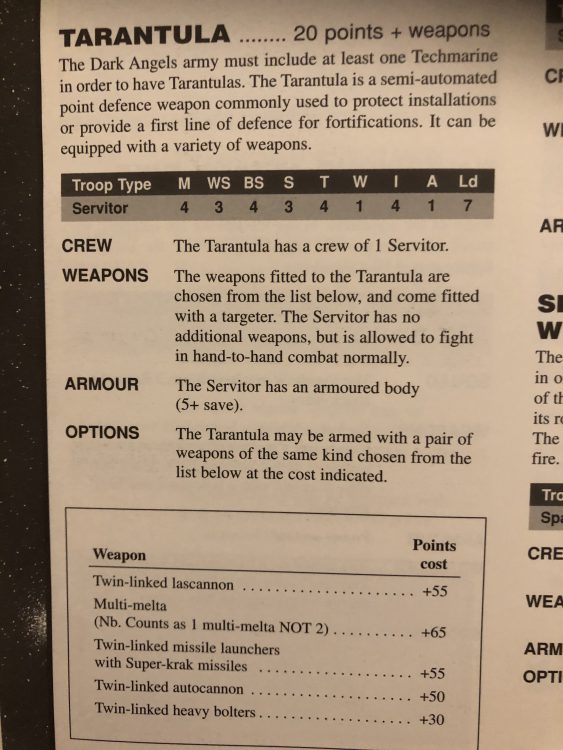
So what else is new here? Or, what’s old now that was new here, compared to what got memory-holed and isn’t even old anymore.
For starters, the first thing you see after opening the book, even before the table of contents, is a diorama of Azrael in the Rock. That very same Azrael model is still on sale today. I hate this company sometimes.
The Lore
There’s a hefty amount of general fluff in here, explaining what Space Marine chapters are, the Horus Heresy, power armor, etc, which I can only assume is re-printed from the other two marine codex that existed at the time. It’s mildly surprising to see how much the background was thought out, back when the 40k universe was a lot smaller and weirder, but a good bit of the fluff – not just the broad strokes, but even a lot of specific story beats – was nailed down 25 years ago.
The Dark Angels’ story burst fully-formed from the heads of Rick Priestly and Jervis Johnson (the staff on this book, my god, it’s an absolute rogues’ gallery of the best that have ever done it) and while it’s been expanded greatly since then, the core of it hasn’t changed much, if at all. The Lion, Caliban, The Order, Luther, the end of the Heresy with the fall of Caliban and the creation of the Rock, the hunt for the Fallen, even ol’ Lion-o napping it off in the dungeon, all of it is here, already. The Lion and the Wolf is (are?) here, Asmodai is still a huge dingus that nobody likes, it’s everything you expect, much earlier than I knew to expect it.
The Blood Angels have fluff, also.
It is of course very stupid, but it does have this gem, right after the blood angels get done going beast mode on a bunker full of rebels, and have a little chat with their Imperial Guard buddies:
The Blood Angel halted and leant forward, his visor mere inches from the Guardsman’s face. There was a moment of tense silence as the Mordian dared not imagine what might happen next. A sound like a low growl emerged from the Space Marine’s helmet. “Praise be to the Emperor!” he suddenly roared and then, turning on his heels, marched away with his squad across the churned up battlefield.
This is a hard as hell thing to scream at a person.
Forces of the Space Marines
The game content starts off with some army-wide rules, including Rapid Fire (marines can shoot twice if stationary, which is functionally what modern Bolter Discipline does), and a note about Break Tests that, if you look at it from the right angle, is basically the precursor to ATSKNF (instead of Breaking, marines just get Shaken, which means they can act more or less normally until they fail a second test, and become both Shaken and Breaken). Neat!
Then we get a look at each unit, mixed fluff and stats, peppered throughout with charming and distinctive Wayne England skulls. This version of the Deathwing are immune to psychology, which back in the day was not the same as being Fearless or otherwise immune to morale, meaning that break tests were still a thing. Not great! Ravenwing have a version of Jink that adds an additional -1 penalty when attempting to shoot at them, on top of the to-hit penalties that 2nd already had, which I definitely knew about before reading this. They also have Expert Riders, and can re-roll whatever a Bike Skid test is.
I’m being told by my editors that I have to offer equal time to the Blood Angels here, so I will state for the record that Death Company have “1+1” wounds. Meaning that if they lose 2 wounds during the battle they die, as you’d expect, but also that if they only lose 1 and survive to the end, they finish the battle and then die, which still affects your Victory Points. In conclusion, Blood Angels can go to hell.
This section kicks butt. It still exists in a similar fashion in modern codices, and this version is missing most of the art work and all of the color, but I like to imagine how cool Terminators would have seemed to me if I’d gotten my hands on this book when it was new and I was 13. It took me a few years longer to find Warhammer, and probably didn’t land quite as hard when it did (though, given what I am writing literally right this moment, and where, clearly it made some kind of impression), but I would have gone nuts seeing words like primarch or Whirlwind Multi-Launcher at that age. It’s almost unfair how laser-targeted this book is at the “wow cool robot” lobe of the adolescent brain. Speaking of which…
Angels of Death
This is the coolest part of the book, hands-down, and also the only one with full-color spreads of models, which I don’t think is a coincidence. These are 2nd edition metals, and it’s wild to see those squat lumpy goobers in their prime.
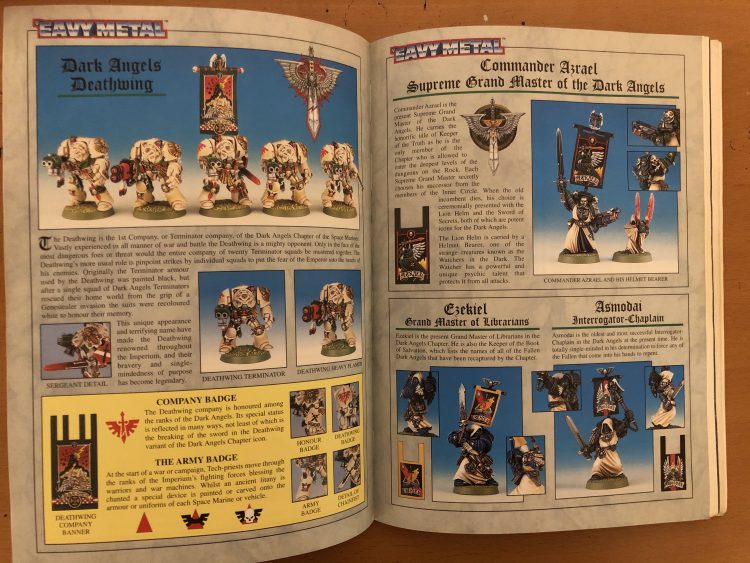
There’s a page each of Dark Angels and Blood Angels successors (fun fact: the old flesh tearers? Real bad), an incredibly sick drawing of Asmodai, which I own on a shirt because it kicks such high volumes of ass, then like 4 pages of just the baddest shit – Tactical Marines, Deathwing Terminators (so sick), tiny old Azrael. God, these Terminators models are so good. This army has always had the best model range even when the rules have sucked. Then there’s some heraldry stuff for nerds, a few banners to represent the Sacred Standards that are just begging to be cut out of the book and glued to models, and a cool Dreadnought.
This section, between the heraldry and the ‘Eavy Metal paint jobs, runs about a dozen pages, and it is by far the best thing in the codex. My favorite detail is that at no point does it even attempt to explain how to get these results. Later editions would include army lists and paint recipes with step-by-step guides, but not here. No, you just get the finished product, and can figure it out on your own how they got there, you absolute ignoramus.
Then you have basically the same thing, but in red. Pass.
Wargear cards and Datafaxes
Ah cool, rules content, the part of this codex that has aged the worst. If you aren’t familiar (read: old) Wargear Cards are basically relics – you can’t take them more than once, non-characters can’t take any at all, and characters generally have a pretty restricted list of accessible items. The ones here are mostly specific to named characters in the book. The Standards of Fortitude, Retribution, and Devastation and Azrael’s Sword of Secrets and Lion Helm get their first appearance, and it becomes increasingly obvious that GW has had no new ideas for Dark Angels since.
The datafax for the Ravenwing Landspeeder is quite a thing. It’s a good argument for not playing 2nd edition, even as a joke, and leaves me wondering how this game is still alive when this is how it started. The Whirlwind, which appears to have been introduced in this book (a trend that would continue with Blood Angels getting first crack at the Stormraven Gunship years later) is even worse:
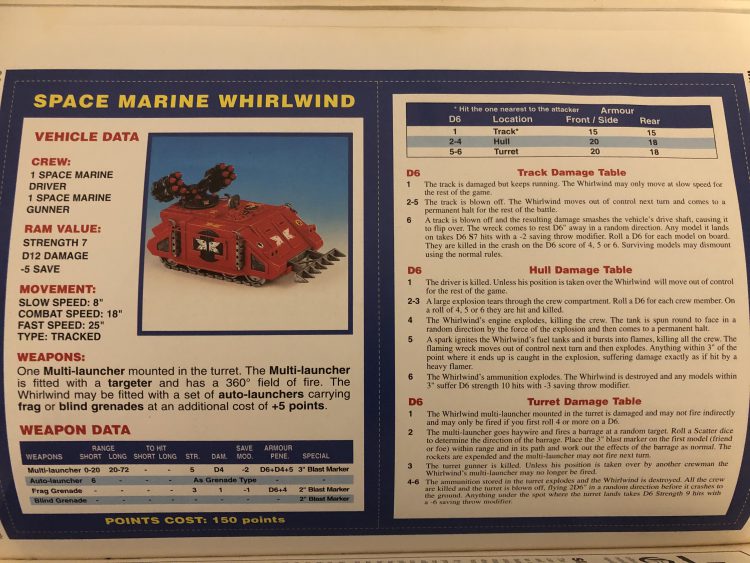
This isn’t even “crunch” in the commonly accepted sense, it’s just a bunch of extra steps to get to the same result. Rube Goldberg-ass game design. Note that if the turret explodes on you it hits harder than the entire tank exploding. I’m convinced that this is because the tank is plastic, and the turret is metal. You knew this, but the crayola crayon dispenser, balanced on a toothpick, is made of 100% lead.
Army Lists
This is divided into three sections: a general section with the armory and some rules, and then a set of uh, I don’t want to call these datasheets, but basically they’re datasheets, for the Dark Angels and Blood Angels.
Hilariously neither of these are proper supplements. The technology to refer to existing books didn’t exist yet, so they straight up reprint things like the tactical squad entry, and they actually do it twice, because there’s a Dark Angels and a Blood Angels version.
Rules for Both Armies
Look away if you are easily unsettled, for this is Peak Second Edition.
To start, would you like some help determining a good size for a battle? Well, simply select 100-300 points of models per foot of table available. There you go, your 52” dining room table is good for between 433 and 1299 points, simple as.
Now let’s pick an army. Perhaps you would like to use a helpful framework such as Detachments, or Formations, or even the old 1HQ+2TR FoC. You absolutely may not do that. There are no required or optional units or slots, everything is either a “squad” or a “character” or “support”, and the rules are, as much as I’m enjoying making fun of them, kind of elegant. The only restrictions are that, out of your points allocation, 25-100% can be spent on squads, 0-50% on characters and 0-50% on support, and you must take a Techmarine to take any vehicles bigger than a bike. Yes, bikes are vehicles.
Given that a Tactical Squad is 300 points for ten marines, that 25% Squads limitation isn’t even as onerous as filling out Detachments is in 9th – in a 2000 point game, 20 marines will do it, and if you want to bring Terminators it’s entirely possible to hit 25% of a 2000 point list with a single squad of 5 models.
As for what qualifies as support versus squads, they did something really interesting with the two armies, and moved the units around. What I love about this is that it enables the three main builds everyone wants from this codex, without a single army-wide exception to the rules or taking a penalty: Blood Angels can run their all-jump infantry because Veteran and regular Assault squads are, uh, squads. For the Dark Angels, they moved Deathwing Terminators, Attack Bikes, and Land Speeders from support to squads, and each has their own Master of the ‘wing character, which enables pure Ravenwing and Deathwing armies. It’s honestly a better and more streamlined solution than anything they’ve tried since.
I’d be remiss if I didn’t mention some of the bonkers wargear options. I think these probably made sense at some point, but nowadays it has a very “buying 50 feet of rope at the inn before starting your D&D adventure” energy. Missile launchers then, as now, came with Frag and Krak rounds for free, but for 5 points each, you could purchase Plasma (hell yeah), Melta (pretty cool), or the dreaded Anti-Plant (??) missiles. Also, bafflingly, the story behind The Lion and The Wolf is in this section.
Dark Angels Army List

Characters
Here we have the Master of the Deathwing, and of the Ravenwing, and neither one has a name. The RW version can opt to ride on a bike or in a Landspeeder, which I think means he could also select neither and just walk around like a chump. Sammael with one too many DUIs, catching Fallen on foot until he completes his court-ordered treatment.
There are Chaplains and Librarians, which do the usual. Something here that I really dig, and they kind of recapture this with the Chapter Command upgrades in 9th, but there are multiple levels of each. Chaplains can be a Champion, Interrogator-Chaplain, or Master Chaplain, and Librarians can advance from Lexicanium to Codicier, Epistolary, and Chief Librarian. The upgraded levels offer better stats – W, I, A, and for the librarian, psychic level. It’s useful for squeezing in a character if you need to scrimp on points vs building a high-octane beatstick, but mostly I like it from a narrative perspective, customizing just how powerful your wizard is. I miss when Warhammer had more dumb stuff like this.
The Techmarine is worth noting as well because, as mentioned previously, without him you can’t take any vehicles. Not even a Dreadnought. Dark Angels get a carve-out here on account of how insanely cool they are, which lets them take Attack Bikes and Landspeeders without some Martian dork complaining about servo-maintenance or whatever, an advantage that the Blood Angels don’t have, because they’re nerds.
Squads
The legally-mandated meat of your army. This is every type of unit with more than one model in it, so Tactical/Assault/Devastator/Scout squads, Terminators, the aforementioned Ravenwing stuff. Most of these come in fixed sizes, and all of their points costs are insultingly high.
Five Deathwing Terminators, which is the only amount of terminators you are allowed to take, is 340 points. It’s trivially easy to get them up to 400 with wargear, and then, supposing you want to Deep Strike the squad, you pay a mere 50% premium for the privilege. Sure, five models for 600 points sounds bad, but consider this: it’s actually worse, due to they only have one wound each, and despite taking their 3+ save on 2d6 (that is, an AP0 attack would be saved on anything except snake eyes), there is no mention of an invulnerable save. Hell yeah.
Granted, second Edition points costs are high across the board, but compared to that, Tactical squads begin to look like a downright bargain at 300. Landspeeders will run you 195 and only come in the Heavy Bolter/Assault Cannon flavor. Bikes are 55 points a model, Attack Bikes are 120. It’s almost impressive how long the games took to play, considering how few models were in a typical army. Really speaks to the complexity of the rules, which is very cool.
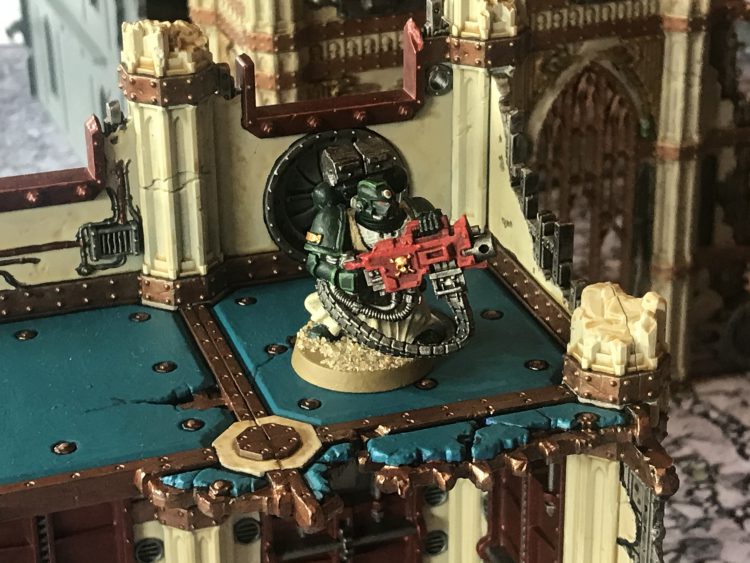
Support
I won’t say much about these, since it’s the same heavy armor you’re used to – Dreadnoughts, Rhinos, Razorbacks, Whirlwinds, and Predators – everything on a Rhino chassis bar the Vindicator, which I guess didn’t exist yet.
The only parts of this that rule are:
- The thing about needing to take a Techmarine to use any of them.
- Land Raiders, in open defiance of the entire ethos of 2nd edition, are cheaper here than they have ever been since. 220 points!
- The tank stats aren’t here. The entries in this part of the book have the stats for the crew, but the tanks themselves are god knows where. I am now being informed that you need the cards for this, but it seems like something that the codex should maybe have mentioned!
Oh, and you can take Allies, but only other marines and guard, that’s it, because the Dark Angels are racist as hell. Not cool!
Special Characters
These seem to pre-date the “your army has to be 2000 points” and “you have to ask permission” rules, thank god. A rare instance of rules restraint in what is otherwise a cesspool of baroque overwrought nonsense.
Azrael still has his 4++ bubble, that’s only within 3 inches, but it works on psychic powers. His sword has an incredibly 2nd edition AP of checks notes d6+d12+6. What in the absolute hell is this.
Ezekial absolutely rips. Look at this wargear:
FORCE SWORD 10 points
Phased crystalline patterns along the force sword’s blade coil iridescent psychic energy around it like a snake. At the end of the psychic phase one unused Force card may be stored in the force sword instead of being placed on the Warp cards discard pile. The stored Force card may be retrieved from the weapon and used in subsequent psychic phases. In hand-to-hand combat the force sword increases the wielder’s Strength characteristic by a number equal to his mastery level and wounds daemons automatically with no saving throw possible. The wielder may also expend the stored Force card to gain an extra +2 Strength and -2 armour save in hand-to-hand combat. The force sword can be used to parry.
My dude is at level 4, so he’s hitting at S9, and +2 more if you slam the Force button. He also carries a big stupid book that does nothing for him except +1WS, and if he dies and nobody else picks the book up you lose 10 VPs, which is very Dark Angels.
Brother Bethor? more like Brother Bear-thor, of the Sacred standards. Look there’s a lot of units here, these can’t all be winners. 25 points to always get a hit in even if you lose the combat (?), or 50 points to either move and rapid fire, or always get overwatch. The former owns because it lets you kill a guy even if you’re getting stabbed, and the latter combine into something resembling various Grims Resolve from different future editions.
Sapphon is 160 points, and a master chaplain. Oh look, the dark angels finally get a Master of Sanctity.
Asmodai is here also. He has instant death knives. Knifin’ around, cut cut cut cut cut.
Blood Angels Army List

If you’re noticing that I’ve half-assed the Blood Angels parts of this review, you are correct. Partly this is Goonhammer’s well-documented Unforgiven bias, and partly it’s just that the Dark Angels content keeps coming first and I waste all the good words on them before I get to these guys.
Characters
The chaplains have new names: Champion, Hero, Mighty Hero – but work the same. It’s a nice bit of extremely anti-keywords energy.
Squads
Like I said, you can run your all-jump army, because you don’t need to take “troops”, because that taxonomy doesn’t exist. They’re all just “squads”. Blood Angels do get their own unique unit, Veteran Assault Squads, which cost an extra 30 points but gain +1 WS/BS/I/Ld, giving them 5, 5, 5, and 9, respectively. A fun thing about this book is that it plays around with Initiative a lot more than the later editions would, where basically everything was I4.
Then there’s Death Company, and we need to talk about this. They’re a 0-1 unit, and you have to take a Chaplain to lead them. The unit starts at 5 dudes, with no maximum at all. Quote: “There is no formal unit size or maximum size for the Death Company.” This is the only variable size infantry squad in either list – Terminators and Scouts are 5, and anything else in power armor is 10. Also they can all have jump packs, and assault weapons. It’s entirely possible, I think, to have a 2000 point army consisting of a single gigantic unit of powerfist-ing jump psychos. At least, until the Chaplain dies, at which point every single one of them starts freelance murdering. They lose cohesion and move randomly, charging head-first into combat. I don’t think I need to really say this, but: hell yeah.
Otherwise it’s the same as Dark Angels, pretty much.
Support
Nah.
Special Characters
Dante you old dusty-ass freak, you and your half-price Veteran bodyguard squad. Check out this wargear, though:
CONVERSION FIELD 10 points
A successful save causes a blinding flash of light that illuminates an area with a radius equal to the Strength of the attacker or the weapon in inches. Any models within this area that have no eye protection will be blinded on a roll of 4, 5 or 6 on a D6 until the beginning of their next turn. Models that are blinded cannot move or shoot, and fight in hand-to-hand combat with a WS of l.
So, to recap:
- The radius is the strength of the attack in inches. Cool, extra measuring.
- Then more dice rolls. A 4+ to go blind or not.
- Oh, and it’s models by the way, not units, so bring extra dice.
- It also posits the existence of “eye protection” which I guess is keyword: GOGGLES?
- You have to track blindness now.
This is some extremely 2nd edition shit, just fetishizing maximum complexity. I would honestly rather fail every single one of my saves, than have to deal with this even once.
Mephiston gets two pages, each more incredibly arch-Dracula than the last. One of them is his rules, where he can hypnotize people and chug blood instead of fighting. The other is Mark Gibbon’s stone-cold classic art:
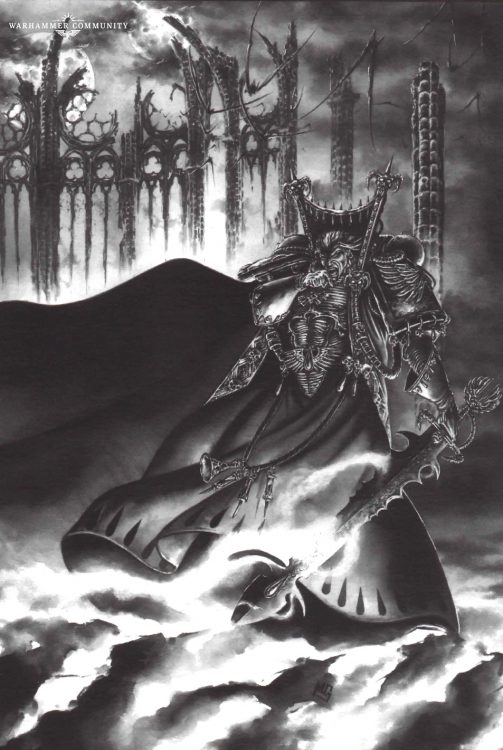
Corbulo exists.
Tycho doesn’t have his Death Company version yet, but he does have the special rule “HATES ORKS”, so maybe this is the real racism chapter.
Advertisements
A two-page spread of other fine codexes and gaming products available to purchase, and also Space Wolves. I kinda love the naked pushing on display here, it rules. Just pick up another army, what could go wrong. This is followed by, I am not exaggerating, a further 22 pages of basically a mail-order bits catalog, in the codex.
I’d be upset about it, but this section is laden with incredibly dope Jes Goodwin models, several of which (Azrael, Tycho, Dante) are still currently for sale in the year of our lord two thousand and twenty one. This is a close runner-up to the ‘Eavy Metal section in terms of what would have put my teenage brain on absolute tilt and siphoned all my allowance money directly into my nearest GW.
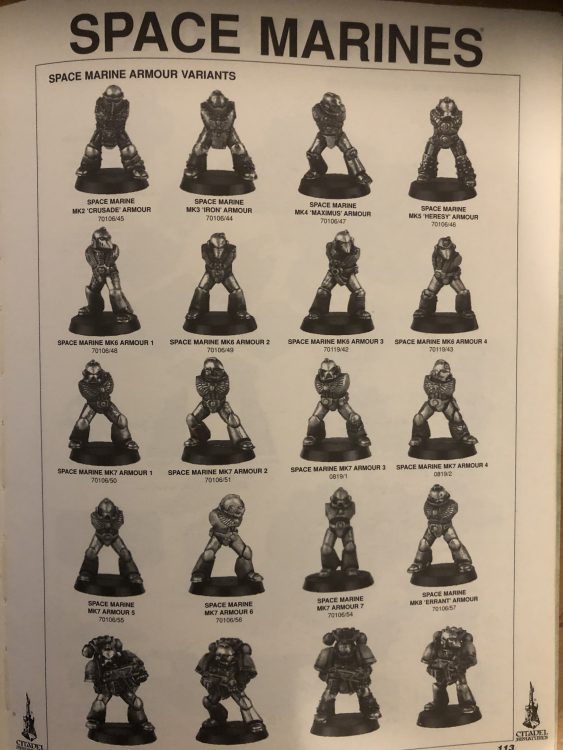
By the way, these are made out of lead, the book does say that.
Also, quick question, since these are all either generic Space Marines or Blood/Dark Angel sculpts, but who let Calgar in here? What the hell is your problem, dude, go away.
Final Thoughts
To be fair, which I don’t really want to be, but as one out-dated product of the 20th century that hasn’t aged well reviewing another, I should at least try to be: I am reading this from the future, where it’s easy to throw stones. Yes, it seems like a clunky first draft, but that’s because it kind of is. I certainly don’t claim that I could have done better. The only reason I’m looking at this like it just crawled out of the Wargaming Bog and slapped wet rules down is because I’m seeing it with the benefit of knowing what this rules team would accomplish 20+ years later. All of that was built off of this, and I have to respect what they did here, capturing the imagination of an entire generation of nerds.
Almost nothing here is still the same in rules-terms. Oddly enough, Movement is back now, but Initiative is gone, and things like AP and WS/BS work completely differently. But in other ways, it’s weirdly familiar. Even the organization of the book: the same sections are here, in the same order, for fluff, unit details, hobby, army-wide rules, and datasheets. Still has the ‘Eavy Metal branding, even. The fluff hits a lot of the same notes, albeit not with the same level of detail that it would accumulate down the road, but it’s still recognizably a 40k product.
It’s cool to see how the game has changed. Again, I never played this when it was new, so seeing static squad sizes all over the place, really limited gun options on vehicles, the Techmarine being so important to unlocking units (I’ve mentioned this like four times because it’s deeply strange to me), it’s all new to me. I never knew that 40k was ever like this. For our younger readers: imagine if I told you that I used to have to actively connect to the internet and it took up our phone line, which was part of the house. That’s the level of culture shock I’m dealing with here.
For something that went for $20 back in the day, there’s a lot of book here – over 100 pages even before you factor in the catalog pages. It’s not full-color, and it’s soft cover, but still, amazing value for money.
This isn’t at all a hot take, but I truly adore this book. As an artifact, if not a gaming piece, it rules. Classic art from John Blanche, Wayne England (who I learned while researching this piece passed away a few years ago. Absolute unironically R.I.P. to a real one), Mark Gibbons, and Des Hanley, some real interesting rules from Rick Priestly and Jervis Johnson (Jervis: come on Goonhammer), and work from the ‘Eavy Metal team that still, to this day, despite having garbage paints to work with, looks incredible on Jes Goodwin sculpts.
If you can find a copy of this somewhere, and are at all interested in Dark Angels, pick it up and flip through it. Blood Angels too, I guess.
